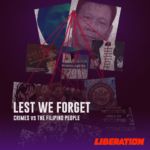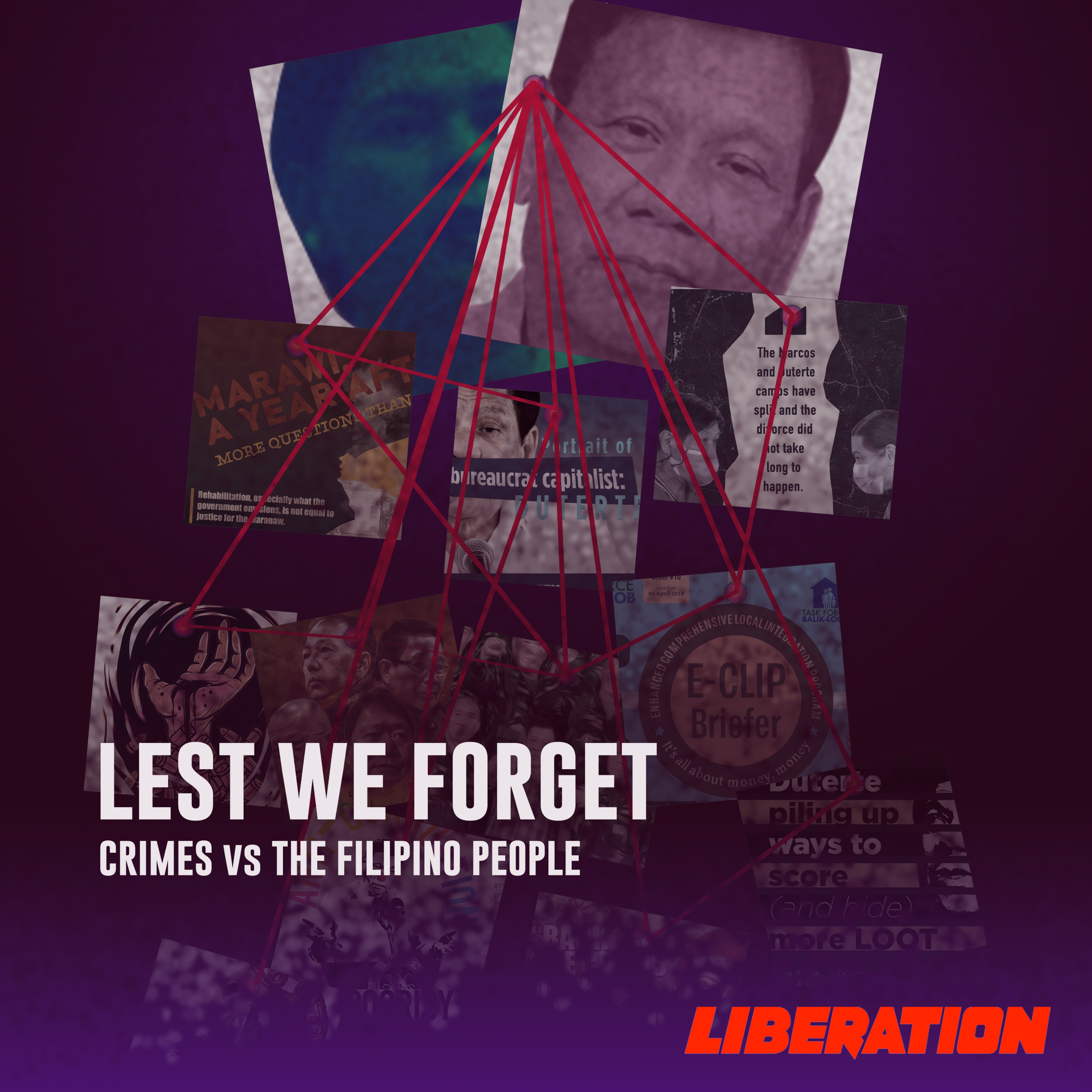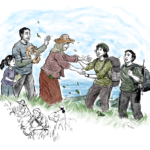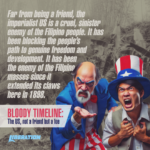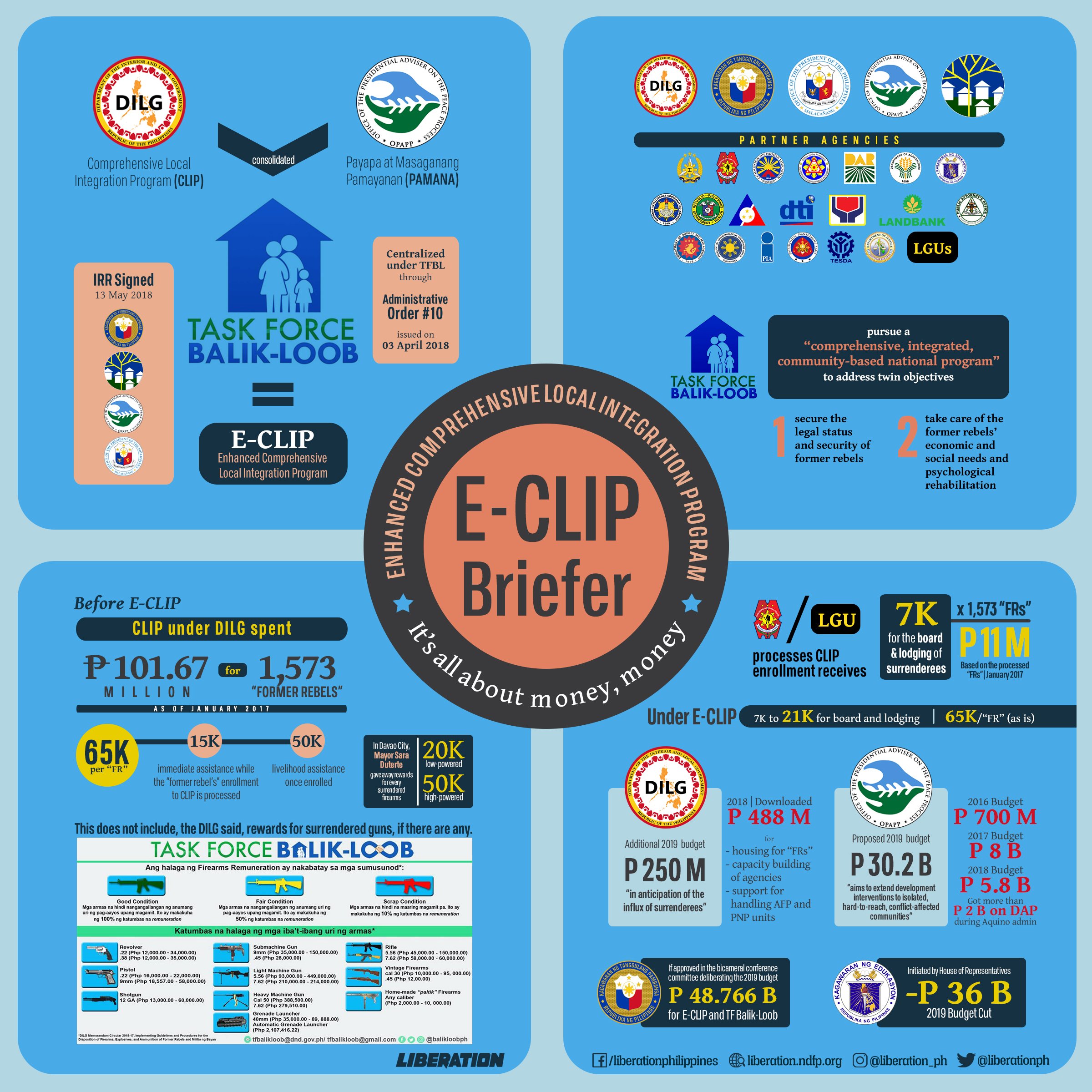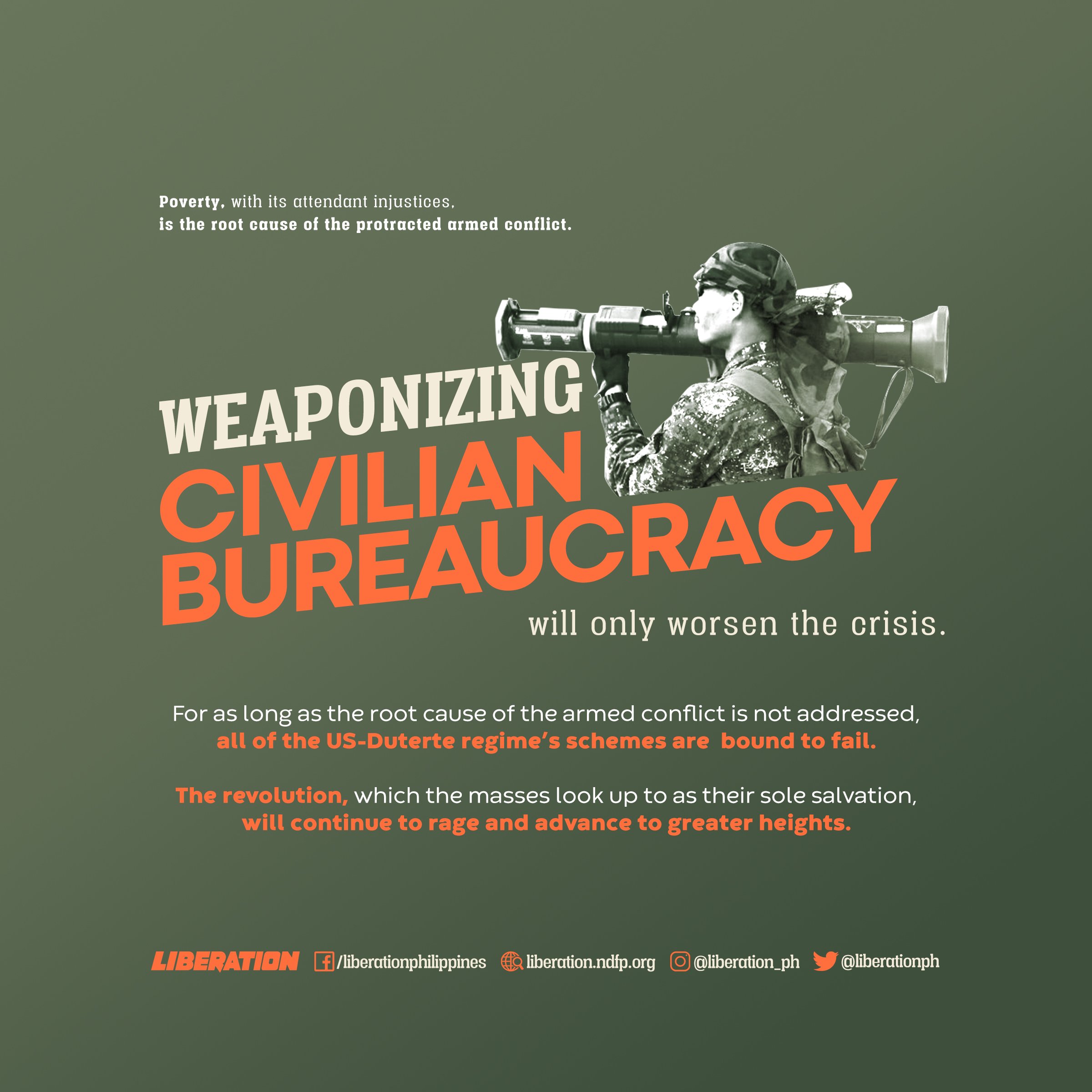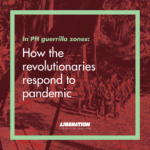Kung paano nananaig ang rebolusyon sa kabila ng mga atake
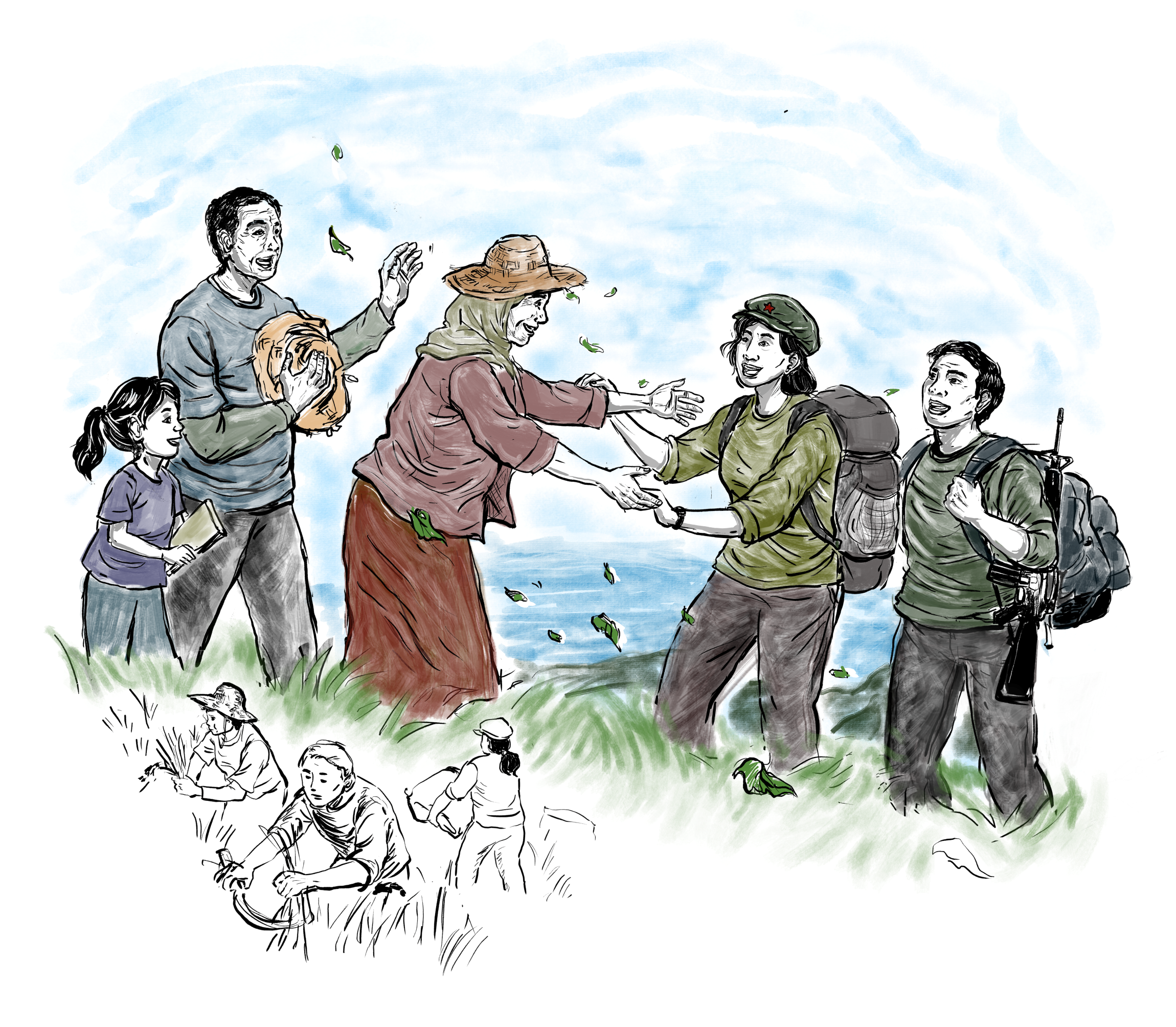
Tinanong ni Ka Andie ang sarili kung “mananatili pa ba ako rito o uuwi na sa NCR?” matapos maranasan ang serye ng matitinding atake at pambobomba ng Armed Forces of the Philippines (AFP) sa mga lugar na kinilusan niya. Nasugatan si Ka Andie sa isa mga insidenteng ito. Pero tulad noon, iisa pa rin ang sagot niya sa sarili, “Kung kinaya ng iba, kakayanin ko rin.”
Bahagi si Ka Andie ng gawaing propaganda at publikasyon ng isang rehiyon sa Bisayas, isang dating propesyunal mula sa National Capital Region na nagpasyang kumilos sa kanayunan. Mula noon hanggang ngayon, ang laging nasa isip ni Ka Andie tuwing nahaharap sa mabigat na pagpapasya ay “Kung kinaya ng iba, kakayanin ko rin.”
Normal lang daw ang self-doubt, sabi ni Ka Andie. “Talagang may pag-aalinlangan sa sarili, sa gawain, sa kakayahan. Di ka bubuhayin ng pride, lalo na kung dahil sa pride ay di ka magbubukas sa collective. Importante ang pagbubukas sa collective para makahanap ng wastong solusyon sa mga kinakaharap na usapin, maging sa usapin ng security.”
Pero higit sa pasya ng mga indibidwal na manatili sa kanayunan, sa hukbo, tinukoy ni Ka Andie ang mga susi para manaig ang rebolusyonaryong kilusan sa kabila ng mararahas na atake ng rehimeng Marcos Jr sa pamamagitan ng AFP, Philippine National Police, at ng NTF-ELCAC. Ito ang ibinahagi ni Ka Andie sa Liberation.
1. Pamumuno ng Partido sa pagharap sa kaaway
Di maiiwasang may makararanas ng trauma at demoralisasyon sa mga kasama dahil sa tindi ng atake ng kaaway. Hindi rin naman talaga biro ang makaranas ng pambobomba. Kasabay nito, pag masinsin ang operasyon ng kaaway, gutom ang inaabot. Minsan, isang linggo kaming nagsasalo sa niyog; O, talbos ng kamote, o kamote kapalit ng kanin at talbos naman ng kamote ang ulam.
Pero kahit gaano pa kahirap ang dinadanas ng mga kasama, mabilis itong napapangibabawan kung mahusay ang pamumuno ng Partido sa hukbo at sa masa. Sa karanasan namin, ito ang naging mapagpasya para determinadong harapin ng mga rebolusyonaryo ang mga atake ng reaksyunaryong estado. Napapanatili ng Partido ang revolutionary optimism sa hanay ng mga kasama, hukbo, at masa.
Ang Partido ang nangunguna sa tuluy-tuloy na assessment, pag-alam ng mga kahinaan at kalakasan sa pagkilos at pagtugon sa mga sitwasyong kinaharap, at paghalaw ng mga aral para sa mga bagong plano at mga SOPs. Dahil dito, napipigilan ang mga mapaminsalang atake.
Hindi naman sa lahat ng panahon may atake ang kaaway. Sa panahong “tahimik” ang paligid, nakakapaglunsad kami ng crash course halimbawa ng Batayang Kurso ng Partido (BKP). Tuluy-tuloy pa rin naman ang gawaing edukasyon, political work. Pero sa mga baryo, hindi nagiging “tahimik” dahil nakababad ang militar na nagsasagawa ng RCSP (Retooled Community Support Program). Kaya kailangang mag-adjust sa moda ng pagkilos.
Weekly namin ginagawa ang political work sa hukbo at sa masa. May mga discussion groups (DGs) na iba pa sa gawaing edukasyon. Sa mga DGs, tinatalakay namin ang pambansang kalagayan, mga updates sa mass movement, mga karanasan ng ibang bansa noong nakikidigma sila gaya ng sa Vietnam. Malaking tulong ang mga bidyo—mga karanasan ng ibang bansa at mga pagkilos sa lunsod na naka-post sa social media—para sa morale ng mga hukbo. Dito nakikita nila ang mga pagkilos ng iba pang sektor na nagiging inspirasyon din sa mga pagsusulong ng Hukbo sa armadong pakikibaka.
Pinag-aaralan din ang vulnerabilities ng mga kagamitan ng kaaway gaya ng drones, Hermes, Tucano at FA50. Pati nga kaibahan ng tunog ng eroplano, helicopter at drone ay inaaral din ng masa para hindi sila madaling masindak.
Fake news nga ‘yang sinasabing wala na ang mga guerrilla fronts. Sa amin, pagkatapos ng pambobomba, nakapag-celebrate pa kami ng anibersaryo ng Partido. Malaki ang pormasyon ng hukbo na nandun, nakapag-spaghetti pa kami at, pinaka-importante, nakapagparangal sa mga martir.
Sa pamumuno ng Partido, mas solido ang paglaban sa iba’t-ibang aspeto. Tumitibay ang loob ng mga pwersa at ng masa. Kung wala ang pamumuno ng Partido, humihina ang paglaban.
2. Tambalang hukbo at masa
May pagkakataong parang nakikipag-patintero kami sa mga militar. May insidente pa ngang maraming columns ng kaaway ang nakabangga sa pwesto namin.
Naging mahalagang bahagi ng maniobra ng mga yunit ng hukbo at iba pang mga kasama ang masa. Ang masa ang sumagip sa mga kasama. Sa tulong nila, nakapagmaniobra ang hukbo at nalusutan ang maraming columns ng kaaway. Alam kasi nila ang bawat sulok ng kagubatan, ang mga palatandaang puno at tanim, kahit mga bato at pagitan ng mga puno na maaring lusutan. Mahusay ang orientation nila sa kagubatan.
Importante talaga ang tulungan ng masa at hukbo. Yung husay ng hukbo sa military work at ang natural na kaalaman ng masa sa terrain ay makapangyarihang kombinasyon para sa pagsusulong ng armadong pakikibaka. Napatunayan naman na ‘yan sa mahabang panahon. Sa mga ganyang sitwasyon, ipinapaubaya ko na talaga ang buhay ko sa masa at sa hukbo. Lesson yan sa humility.
Di mo talaga pwedeng ikumpara ang “talino” ng mga peti-B sa talino ng masa, ng magsasaka. Kaya mahalaga ang tulungan ng bawat isa. Marami pang dapat alamin. Yung mga alam nating peti-burges karamihan diyan hindi naman praktikal sa kalagayan ng masa. Magaling naman ang mga peti-b sa paglalatag ng sistema ng gawain, administrasyon. Kaya kailangan ang kumbinasyon ng galing ng bawat isa. Kaya lang, hindi mo ‘to makikita kung kayabangan ang dala mo sa masa.
3. Suporta ng masa
Masa pa rin ang maasahan ng mga kasama kapag wala nang makain. Kapag limitado ang galaw nila sa baryo dahil nga nakababad doon ang mga sundalo, naging unawaan na lang na pwedeng kumuha ng makakain sa mga taniman nila ang mga kasama. Katulong rin ang masa sa pagtatanim at pag-iimbak ng pagkain, bahagi yan ng practice ng war economy sa CS.
Naka-war footing din ang masa sa araw-araw. May relyebo sa pag-gwardya at pagmamanman—lalaki man o babae.
Pero sa totoo lang, ang ganyang relasyon ay bunga naman nang malalim na ugnayan ng masa at ng rebolusyonaryong kilusan. Kung tutuusin, di naman na sila magkaiba. Ang masa at ang hukbo’t mga kasama ay iisa. Bawat pamilya, minsan pa nga ay buong angkan, sa lugar ay may kasama o myembro ng hukbo, di lamang isa o dalawa.
Yung mga tagumpay sa rebolusyong agraryo na inilunsad ng Partido, ng hukbo, ng mga rebolusyonaryong organisasyong masa ang isa sa mga dahilan kung bakit malalim na naka-ugat ang rebolusyonaryong kilusan sa hanay ng masa. Kaya’t hindi kataka-takang automatic na ang tulong ng mga nasa baryo para sa hukbo at mga kasama.
Basta’t nasa tabi ang hukbo, nanatili ang diwang palaban ng masa.
4. Ikatlong kilusang pagwawasto
Para sa akin, ito na ang rurok ng kababaang-loob ng rebolusyonaryong kilusan na pinamumunuan ng Partido—ang pagpuna sa mga sariling pagkakamali, kahit sa publiko.
Naging kamalian din namin ang ilan sa mga nabanggit sa kilusang pagwawasto—yung may paboritong lugar na pinupuntahan o binababaran. Ito yun mga nakasanayang baryo at palagay na ang loob ng mga hukbo.
Pag ganito kasi, maiiwan sa limitadong tao lang ang napapakilos kumpara kung malawak ang naiikutang mga baryo. Nagiging makitid languyan at napapabayaan rin ang ibang lugar. Isang dahilan rin ito na mabilis matitiktikan ng kaaway lalo na kung may naitanim na ispiya sa baryo, mga taong nanggagapang sa base at naniniktik ng bakas ng hukbo at mga kasama. Kailangang mobile talaga para nakakaikot sa iba’t ibang lugar kung nasaan ang masa. Hindi naman nakaka-atake ang kaaway sa lahat ng lugar sa isang takdang panahon kaya hindi imposibleng umikot.
May konserbatismo din kami, halimbawa, ang pag-aalinlangang bumira sa kaaway dahil iniisip na agad ang magiging ganting-salakay nito.
Nakita na ang mga ito bago pa pormal na inilunsad ang ikatlong kilusang pagwawasto. Nauna nang maglunsad ng rectification movement sa region noong pang 2016 pero hindi na-sustain kaya nagpatuloy ang losses. Noong 2018, kasabay halos ng ika-50 anibersaryo ng Partido, nagkaroon na ng resolution na iwasto ang verticalization ng hukbo at paghusayin ang masinsing pakikidigmang gerilya.
Malaking bagay ang rectification movement para makita ang naging kalakasan at kahinaan sa pagsusulong ng digmang bayan. Mahalagang armas ito para salagin ang mga atake ng kaaway.
5. Indibidwal na pagwawasto at pagpapatuloy sa rebolusyon
Hindi naging madali ang adjustments ko sa kanayunan. Mahirap para sa mga peti-burges ang pagtulog sa duyan, o makeshift na kubo sa mga kampuhan lalo na kung sanay sa aircon, malambot na kama, kung sanay sa komportableng buhay sa syudad.
Sa kanayunan ko natutunan ang totoong ibig sabihin ng humility o pagpapakumbaba. Lagi’t lagi pinapaalala sa sarili na hindi ako sapat. Totoo rin naman, sa CS mangmang ka sa maraming bagay. Nalaman kong marami akong di alam sa mundo. Noong umpisa, di nga ako marunong gumawa ng apoy. Magugutom ako dun kahit marunong akong magluto.
Noong simula pa lang, at lalo na ngayon, na-realize ko na kailangan maging mahusay na mag-aaral—hindi lang pormal na pag-aaral kundi maging yung nangyayari sa paligid para tama ang response sa sitwasyon, alam kung ano ang pwedeng gawin. Kahit sa mga usaping security, kailangang pag-aralan ang mga butas.
Ang lahat nang nakakatakot, nagiging less scary if objectified. Lapat lang ng MD (materyalismong diyalektiko), mga pinag-aralan natin sa BKP. Di pwedeng di nag-aaral, nagbabasa at nagtatanong kung bakit ba ako nandito.
Yung asawa ko palagi niyang binabalikan kung bakit siya nasa hukbo, ano ba ang timbang ng mga personal na problema kumpara sa kalagayan ng masa at ang mga ginagawa sa kanila ng mga reaksyunaryong militar. Dito namin hinuhugot ang lakas ng loob para magpatuloy.
Natural namang nakakaisip bumaba o umayaw na. Pero nariyan ang collective para sabihin mo ang mga reservations at tingnan kung ano ang maaaring gawin, ano ang doables. Sa karanasan, ang collective mo pa rin ang tutulong mag-proseso ng mga nararamdaman mo, mga alinlangan, mga kahinaan. Mga ka-collective mo pa rin ang tutulong kung paano iwawasto ang mga kahinaan. Again, kailangan ng humility sa prosesong ito—bukas sa kung paano iwawasto at pangingibabawan ang mga kahinaan. Pagkatapos nung naranasan naming bombing, colective rin ang nakatulong sa psychological at mental recovery namin.
Kasama sa pagiging bukas sa indibidwal na nararamdaman, mga problema, ang pagiging bukas rin sa ideological struggle, healthy ideological struggle para lumitaw kung ano ang mali at tama sa mga naging pagkilos o sa mga kaisipang dala-dala. Mabigat ito para sa iba kaya kailangang maiplasta ang mga pagtingin mo para makatulong, ipaintindi ang mga bagay na hindi ka nakakainsulto. Dito manggagaling ang matibay na pagkakaisa at mabubuo ang mas matatag na Partido para sa higit na ikasusulong ng rebolusyon.
Gagawin natin ang lahat nang sakripisyong ito para sa masa at rebolusyon. Sabi nga, lahat naman tayo mamamatay, kaya isipin na lang natin kung saan at paano tayo makakatulong sa rebolusyon dahil ito ang tama. ###(Priscilla Guzman)

